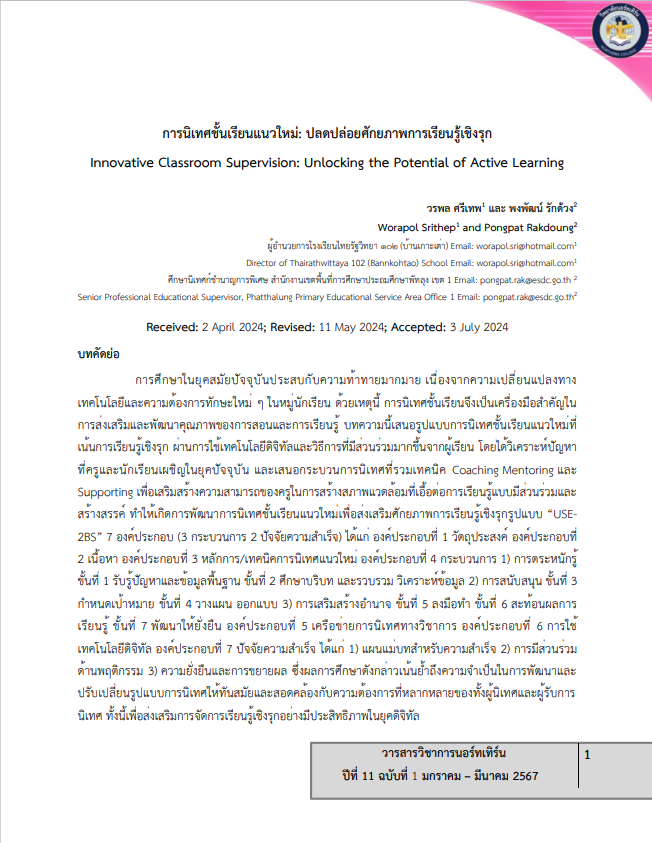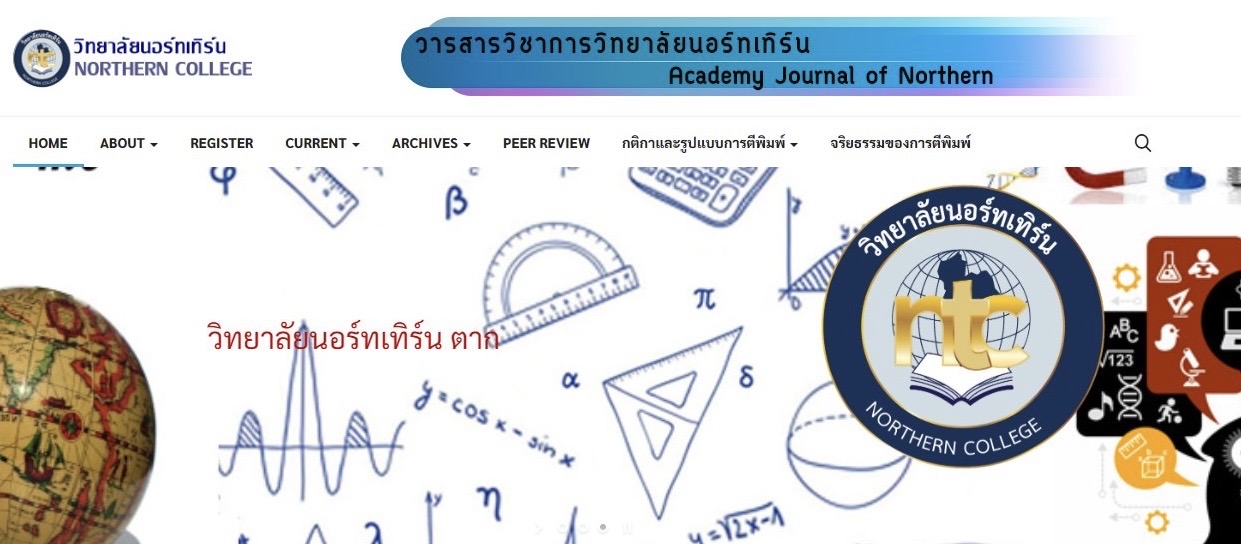Innovative Classroom Supervision: Unlocking the Potential of Active Learning
Keywords:
New Classroom Supervision, Active Learning, “USE-2B” Model with 4 ComponentsAbstract
In the current era, education faces numerous challenges due to technological changes and the demand for new skills among students. As a result, classroom supervision has become a vital tool in enhancing and developing the quality of teaching and learning. This article proposes a new model of classroom supervision that emphasizes proactive learning through the use of digital technology and more participatory methods from learners. By analyzing the problems that teachers and students face today, it introduces a supervision process that integrates Coaching, Mentoring, and Supporting techniques to empower teachers in creating an environment conducive to participatory and creative learning. This leads to the development of a new supervision model to enhance the potential for proactive learning, the “USE-2BS” model, which comprises 7 components (3 processes and 2 success factors): Component 1: Objectives, Component 2: Content, Component 3: New supervision principles/techniques, Component 4: Process 1) Awareness, with Stage 1: Identifying problems and basic information, Stage 2: Studying context and data collection & analysis; 2) Support, with Stage 3: Setting goals, Stage 4: Planning, designing; 3) Empowerment, with Stage 5: Implementation, Stage 6: Reflecting on learning outcomes, Stage 7: Sustainable development; Component 5: Academic supervision network, Component 6: Use of digital technology, Component 7: Success factors, which include 1) A master plan for success, 2) Behavioral participation, 3) Sustainability and scalability. The findings highlight the necessity of developing and modernizing supervision models to be contemporary and align with the diverse needs of both supervisors and supervisees, to promote effective proactive learning management in the digital age.
References
จิติมา วรรณศรี. (2563). นวัตกรรมสู่การพัฒนาสถานศึกษา. พิษณุโลก: รัตนสุวรรณการพิมพ์.
ชาคริยา ชายเกลี้ยง. (2563). รูปแบบการนิเทศแบบผสมผสานเพื่อส่งเสริมการวิจัยของครูระดับมัธยมศึกษา.
วารสารมหาจุฬานาครทรรศน์. 6(10). 5345-5361.
ธิดา ขันดาวงศ์. (2557). การพัฒนารูปแบบการนิเทศแนวใหม่ เพื่อพัฒนาคุณภาพครูปฐมวัย สังกัดสำนักงานคณะกรรมการการศึกษาขั้นพื้นฐาน. วารสารราชพฤกษ์. 12(1). 45-51.
เวียงชัย แสงทอง. (2566). รูปแบบการนิเทศแบบผสมผสานเพื่อส่งเสริมการจัดการเรียนรู้เชิงรุก ของครูโรงเรียนประถมศึกษา. วารสารสันติศึกษาปริทรรศน์. 11(3). 1195-1205.
สรรเพชญ ศิริเกตุ. (2563). การพัฒนารูปแบบการนิเทศภายในแบบมีส่วนร่วมของสถานศึกษา สังกัดสำนักงานส่งเสริมการศึกษานอกระบบและการศึกษาตามอัธยาศัยจังหวัดกาฬสินธุ์. วิทยานิพนธ์การศึกษามหาบัณฑิต, มหาวิทยาลัยมหาสารคาม.
สำนักงานเลขาธิการสภาการศึกษา. (2561). รายงานประจำปี 2561. สำนักงานเลขาธิการสภาการศึกษา.
สำนักงานศึกษาธิการจังหวัดกาฬสินธุ์. (2560). การนิเทศเข้าใจ เข้าถึง พัฒนา. สำนักงานศึกษาธิการจังหวัดกาฬสินธุ์.
สุริยนต์ กัลยาณี. (2566). การจัดการเรียนรู้เชิงรุก (Active Learning) เพื่อพัฒนาทักษะผู้เรียนในศตวรรษที่ 21. https://www.chan1.net/book/2824.
สุคนธ์ สินธพานนท์. (2560). ครูยุคใหม่กับการจัดการเรียนรู้ สู่การศึกษา 4.0. กรุงเทพมหานคร: ศูนย์หนังสือจุฬาลงกรณ์มหาวิทยาลัย.
ศานิต โหนแหย็ม. (2560). สภาพปัญหาการนิเทศภายในสถานศึกษา สังกัดสำนักงานเขตพื้นที่การศึกษา มัธยมศึกษา เขต 18. วิทยานิพนธ์ปริญญามหาบัณฑิต, มหาวิทยาลัยบูรพา.
เอกรัฐ ทุ่งอ่วน. (2566). รูปแบบการนิเทศแนวใหม่ : ทางออกการจัดการเรียนรู้โดยใช้โครงงานเป็นฐาน. วารสารบัณฑิตศึกษาปริทรรศน์ มหาวิทยาลัยมหาจุฬาลงกรณราชวิทยาลัย วิทยาเขตแพร่. 9(1). 241-251.
Bureau of Educational Testing. (2022). Basic National Education Test Report, Academic Year 2021. Bangkok: Office of The Basic Education Commission.
Institute for the Promotion of Teaching Science and Technology (IPST). (2021). PISA 2018 Assessment Results Reading, Mathematics and Science. Bangkok: Institute for the Promotion of Teaching Science and Technology

Downloads
Published
How to Cite
Issue
Section
License

This work is licensed under a Creative Commons Attribution-NonCommercial-NoDerivatives 4.0 International License.






